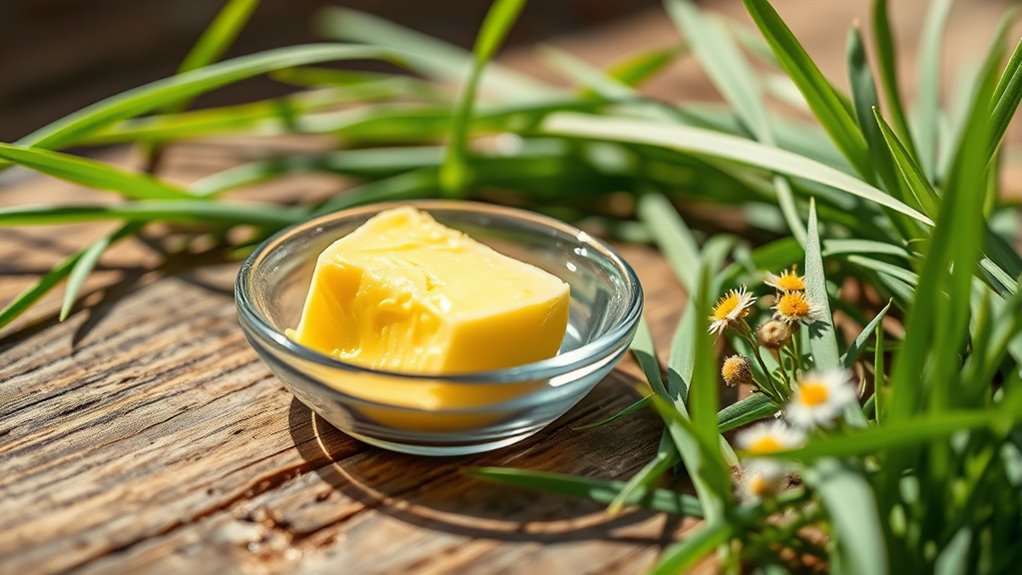Grass-fed butter naturally contains conjugated linoleic acid (CLA), which has been linked to immune support, reduced inflammation, and potential improvements in body composition. Higher CLA levels in grass-fed butter come from the cow’s diet, making it a natural source without supplements. While some studies suggest health benefits, the evidence varies. To discover how CLA can help you and understand its realistic effects, explore the details below.
Key Takeaways
- Grass-fed butter naturally contains higher levels of CLA produced during cow fat metabolism.
- CLA in grass-fed butter may support healthy body composition and fat metabolism.
- Consuming grass-fed butter can help modulate immune response and reduce inflammation.
- CLA intake from grass-fed butter may contribute to lowering chronic disease risks like heart disease and insulin resistance.
- Using grass-fed butter in the diet offers a natural, nutrient-rich source of CLA with potential health benefits.
What Is Conjugated Linoleic Acid (CLA)?

Have you ever wondered what makes grass-fed butter different from conventional options? It all comes down to conjugated linoleic acid, or CLA. This unique fatty acid is produced through CLA synthesis during fatty acid metabolism in cows that graze on lush, green pastures. When cows consume grass, their bodies convert certain fatty acids into CLA, boosting its presence in their milk and butter. CLA has attracted attention because it plays a role in various biological processes, including cell signaling and immune function. Unlike fats from grain-fed cows, grass-fed butter contains higher levels of CLA, thanks to this natural conversion process. Understanding CLA’s origin helps explain why grass-fed butter offers different health benefits compared to conventional dairy options. Additionally, creative practice can be a helpful way to explore new ideas or solutions related to health and nutrition topics.
How Much CLA Is Found in Grass-Fed Butter

Grass-fed butter typically contains higher levels of conjugated linoleic acid compared to conventional butter, reflecting the natural conversion process that occurs in cows grazing on lush pastures. The CLA dosage in grass-fed butter can vary, but generally ranges from 0.2 to 0.4 grams per tablespoon. This amount is markedly higher than in grain-fed butter, emphasizing the grass fed benefits. If you’re seeking a natural source of CLA, choosing grass-fed butter can help you increase your intake without supplements. Keep in mind that the exact CLA content depends on factors like cow diet, breed, and pasture quality. Additionally, the friendly temperament of certain breeds can influence the quality of the milk produced, indirectly affecting CLA levels. Incorporating grass-fed butter into your diet offers a simple way to enjoy the potential benefits associated with CLA naturally present in these products.
The Potential Benefits of CLA for Body Composition

Conjugated linoleic acid (CLA) has garnered attention for its potential to support healthy body composition. Research suggests that CLA may influence metabolic regulation, helping your body manage how it processes and stores fat. It could enhance fat metabolism, making it easier for you to reduce body fat while preserving lean muscle mass. Some studies indicate that CLA might boost your body’s ability to burn fat more efficiently, which can support weight management goals. While results vary, incorporating CLA-rich foods like grass-fed butter might offer subtle benefits for body composition. Keep in mind, though, that CLA isn’t a magic solution, and combining it with a balanced diet and regular exercise remains essential for achieving ideal results. Additionally, understanding high-quality supplements can help optimize your intake of CLA for better health outcomes.
CLA and Immune System Support: What Does the Research Say?
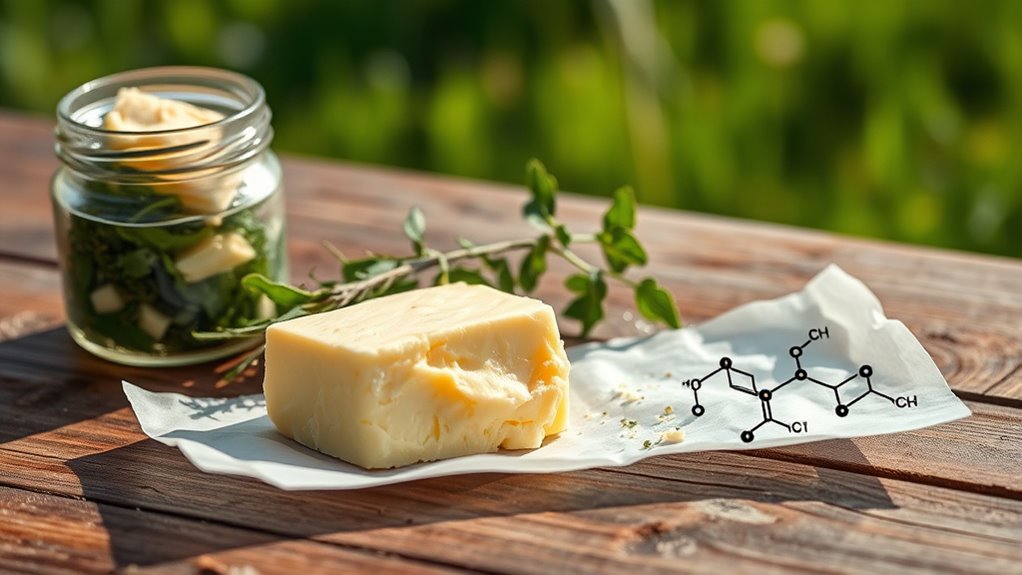
Research suggests that CLA can modulate your immune response and reduce inflammation, potentially boosting your overall health. You might notice these benefits more when consuming grass-fed butter, which contains higher CLA levels. Let’s explore what the science says about how CLA supports your immune system. Additionally, incorporating proper storage and handling of grass-fed butter can help maintain its CLA content and effectiveness.
CLA’s Immune Modulation
Although studies are still ongoing, evidence suggests that CLA plays a role in supporting the immune system by modulating inflammatory responses and enhancing immune cell function. It may influence how your body absorbs vitamins essential for immunity and promote a healthy gut microbiota, which is crucial for immune regulation. You might notice that CLA helps maintain a balanced immune response, reducing unnecessary inflammation while boosting defenses against pathogens. Incorporating dog names that reflect vitality and strength can also inspire positive associations with health and resilience. Consider these points: – Supports vitamin absorption critical for immune health – Modulates inflammatory responses – Promotes a balanced gut microbiota – Enhances immune cell activity – Contributes to overall immune resilience While research continues, integrating CLA-rich foods like grass-fed butter can be a practical way to support your immune modulation naturally.
Anti-inflammatory Effects of CLA
Emerging evidence indicates that CLA has notable anti-inflammatory effects, which can help support your immune system. CLA supplementation has been shown to reduce markers of inflammation, potentially lowering the risk of chronic inflammatory conditions. These benefits are especially linked to grass fed benefits, as grass-fed sources tend to contain higher CLA levels. Research suggests that CLA interacts with immune cells, modulating inflammatory responses and promoting a balanced immune function. By incorporating CLA-rich foods like grass-fed butter into your diet, you may enhance your body’s ability to manage inflammation effectively. Additionally, dietary sources of CLA, such as grass-fed butter, provide a natural way to boost anti-inflammatory intake. While more studies are needed, current findings highlight the potential of CLA to serve as a natural anti-inflammatory agent that supports overall health and immune resilience.
Grass-fed Butter Benefits
Grass-fed butter stands out as a flavorful source of beneficial compounds like conjugated linoleic acid (CLA), which has been linked to immune support and anti-inflammatory effects. By choosing grass-fed butter, you enhance your butter nutrition and enjoy specific grass fed benefits that support your immune system. Research suggests that CLA may help modulate immune responses and reduce inflammation, contributing to overall health. Incorporating this butter into your diet can offer these advantages:
- Supports immune function
- Reduces inflammation
- Provides essential fatty acids
- Enhances nutrient absorption
- Promotes gut health
These benefits highlight how grass-fed butter not only enriches flavor but also boosts your body’s natural defenses, making it a valuable addition to a health-conscious diet. Proper nourishment is essential for maintaining overall well-being and supporting immune health.
Evidence for CLA’s Role in Reducing Inflammation

Research shows that CLA has notable anti-inflammatory properties, which can help calm your body’s inflammatory responses. As inflammation decreases, your immune system may function more efficiently, supporting overall health. This reduction in chronic inflammation could also lower your risk of developing long-term diseases. Sustainable living practices can further enhance your health by promoting eco-friendly choices that benefit both individual well-being and the environment.
Anti-inflammatory Properties Demonstrated
Many studies have shown that conjugated linoleic acid (CLA) can help reduce inflammation in the body. When you incorporate CLA supplementation, you may notice a decrease in inflammatory markers and improved overall health. Unlike saturated fats, which can sometimes promote inflammation, CLA’s unique structure provides anti-inflammatory benefits. Research indicates that CLA helps modulate cytokine production and inhibits inflammatory pathways. This effect is especially relevant when consuming grass-fed butter, rich in natural CLA. To support your health, consider including CLA-rich foods in your diet. Key points include:
- CLA reduces levels of pro-inflammatory cytokines
- It inhibits inflammatory enzyme activity
- It helps balance immune responses
- Grass-fed sources provide natural CLA benefits
- CLA’s effects are distinct from saturated fats’ inflammatory potential
Incorporating CLA can be a strategic move toward less inflammation and better health. Fascinating connection to the role of father-daughter bonds in emotional health, highlighting how familial support can influence overall well-being.
Immune System Support
Evidence shows that CLA plays a significant role in supporting your immune system by reducing inflammation. This can be especially helpful if you have dairy allergies, as CLA-rich grass-fed butter offers a natural way to include beneficial fats without triggering allergic reactions. Additionally, CLA enhances the vitamin content of butter, providing nutrients like vitamin A and E that bolster your immune defenses. By lowering inflammation, CLA helps your body respond more effectively to infections and reduces the risk of immune-related issues. Consuming grass-fed butter with higher CLA levels may strengthen your immune resilience, making it easier for your system to fight off illnesses. Incorporating CLA-rich foods like grass-fed butter could be a simple step toward better immune support. Somatic therapy techniques emphasize the importance of physical sensations and stress reduction, which can further support immune health by reducing overall bodily stress.
Reduced Chronic Disease Risk
Supporting your immune system by reducing inflammation also plays a key role in lowering the risk of chronic diseases such as heart disease, diabetes, and certain cancers. CLA in grass-fed butter helps modulate inflammatory responses, which can protect you from these conditions. For example, it may:
- Decrease inflammation linked to dairy allergies, easing symptoms
- Support healthy blood vessel function, reducing heart disease risk
- Improve insulin sensitivity, aiding diabetes management
- Modulate immune responses involved in cancer development
- Influence butter manufacturing processes to retain beneficial CLA levels
Choosing grass-fed butter ensures higher CLA content, making it a smarter choice for reducing chronic disease risk. By understanding these benefits, you can make informed dietary decisions that support long-term health and resilience.
Are There Any Risks Associated With CLA Consumption?
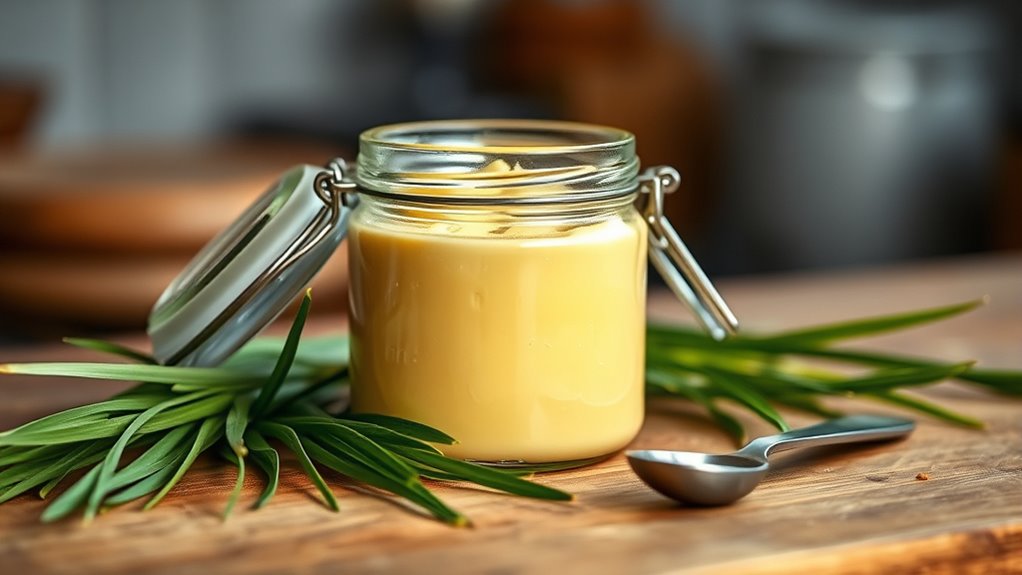
While conjugated linoleic acid (CLA) is generally considered safe when consumed in moderate amounts, some individuals may experience side effects or health concerns. Potential allergen concerns are rare but possible, especially if you have sensitivities to dairy products. Additionally, environmental impact considerations come into play, as high CLA intake from large-scale production might affect ecosystems. Be aware of these risks:
| Concern | Explanation |
|---|---|
| Potential allergen concerns | Allergic reactions from dairy-based CLA sources |
| Side effects | Mild gastrointestinal discomfort or diarrhea in some cases |
| Environmental impact considerations | Excessive production could impact land and water resources |
If you’re worried, consult a healthcare professional to determine safe CLA consumption levels.
Comparing Grass-Fed Butter to Other Sources of CLA
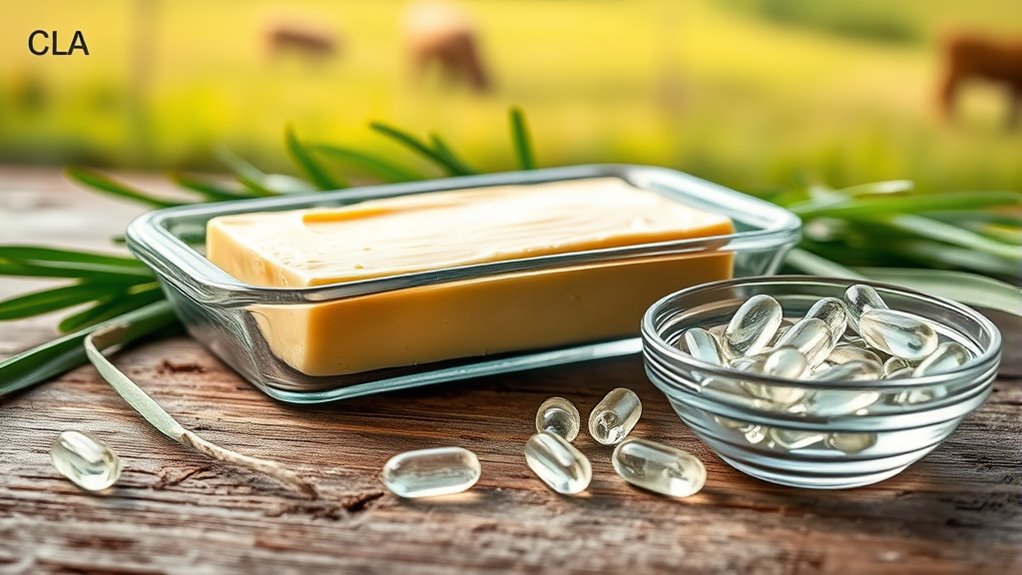
Grass-fed butter is a popular and natural source of CLA, but it’s not the only option available. When comparing grass-fed versus conventional dairy, grass-fed butter tends to have higher CLA levels due to the animals’ diet. If you consider dairy versus supplements, supplements often provide concentrated CLA doses, but may lack other beneficial nutrients found in whole foods. Here’s how they differ:
- Grass-fed butter offers a natural, nutrient-rich source with balanced fats.
- Conventional dairy usually has lower CLA levels due to different feeding practices.
- Supplements provide higher, more controlled doses but lack accompanying nutrients.
- Grass-fed options support sustainable farming and animal welfare.
- The choice depends on your health goals, preference for whole foods, and dietary restrictions.
Ultimately, both sources can contribute to your CLA intake, but grass-fed butter combines health benefits with natural richness.
Practical Ways to Incorporate Grass-Fed Butter Into Your Diet

Incorporating grass-fed butter into your daily routine is simpler than many realize. Start by using it as a flavorful alternative to margarine or processed spreads. Cooking tips include melting it over vegetables, sautéing proteins, or stirring it into grains for added richness. Its natural flavor enhances dishes without overpowering them, making it perfect for flavor enhancements. Spread it on whole-grain toast or mix into mashed potatoes for a creamy texture. You can also incorporate small amounts into baked goods, like muffins or cookies, to boost nutritional value. Keep in mind that grass-fed butter’s unique taste can elevate simple recipes, making healthy eating both enjoyable and satisfying. With these practical tips, you’ll effortlessly enjoy the benefits of CLA-rich butter in your everyday meals.
Clarifying Misconceptions and Marketing Claims About CLA
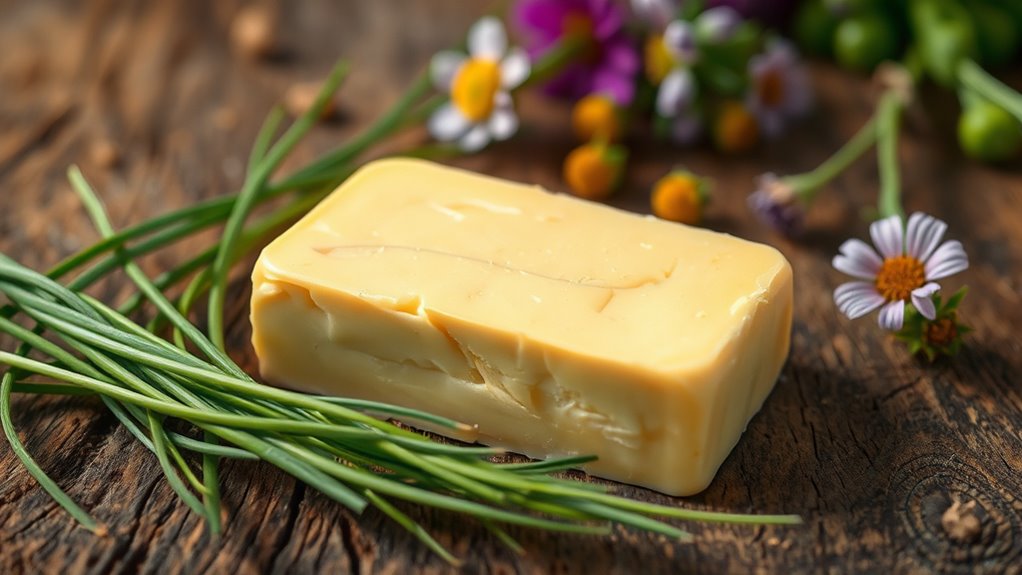
Many marketing claims about CLA can be misleading or exaggerated, making it important for you to critically evaluate sources. The marketing hype often promises dramatic health benefits without solid scientific evidence to back them up. To cut through the noise, consider these points:
Claims about CLA are often exaggerated; always verify scientific evidence before believing marketing hype.
- Not all CLA supplements contain the same effective doses.
- Many claims lack rigorous scientific proof.
- Grass-fed butter naturally contains CLA, but amounts vary.
- Some marketing overstates CLA’s impact on weight loss or immunity.
- Always check for credible sources and peer-reviewed studies.
Understanding the difference between genuine scientific evidence and hype helps you make informed decisions. While CLA in grass-fed butter can be beneficial, be cautious of exaggerated promises rooted in marketing hype. Focus on credible information to guide your choices.
Frequently Asked Questions
How Does Grass-Fed Butter Compare to Other Dairy Products for CLA Content?
You’ll find that grass-fed butter generally has a higher dairy fat CLA concentration than most other dairy products like milk or cheese. This is because the cows’ diet influences the CLA levels in their fat, and grass feeding boosts this content. So, if you’re aiming for more CLA, grass-fed butter might be your best option, providing a richer source of this beneficial compound compared to conventional dairy fats.
Can CLA From Grass-Fed Butter Help With Weight Loss in Humans?
Imagine your body as a finely-tuned engine, craving the right fuel to burn fat effectively. While CLA from grass-fed butter shows promise, it’s not a magic wand for weight loss. Combining regular exercise benefits with mindful calorie considerations makes the biggest impact. Incorporate grass-fed butter into balanced meals, but remember, sustainable weight loss comes from consistent effort, not just a single ingredient.
What Is the Optimal Daily Intake of CLA for Health Benefits?
You might wonder about the ideal CLA dosage for health benefits. Research suggests that a daily intake of around 3 to 5 grams can support health maximization, including weight management and improved body composition. However, individual responses vary, so it’s best to start with lower doses and consult a healthcare professional. Consistency is key, but avoid exceeding recommended amounts to prevent potential side effects.
Are There Differences in CLA Levels Between Grass-Fed and Grain-Fed Butter?
Imagine nature’s palette—grass-fed butter is richer in CLA, thanks to pasture impact, which influences milk composition. You’ll find higher CLA levels in grass-fed butter compared to grain-fed, because cows grazing on pasture produce milk with more beneficial fats. This difference emphasizes the nutritional edge of pasture-based diets, making grass-fed butter a smarter choice for anyone seeking health benefits from their fats.
How Stable Is CLA During Butter Processing and Storage?
You might wonder about processing stability and storage degradation of CLA in butter. During processing, CLA remains relatively stable if temperatures stay moderate, but high heat can cause some breakdown. In storage, exposure to light, oxygen, and heat accelerates degradation, reducing CLA content over time. To maximize benefits, keep butter in a cool, dark place and limit prolonged exposure to air, ensuring the CLA stays as intact as possible.
Conclusion
Imagine spreading a dollop of rich, golden grass-fed butter on your morning toast, knowing you’re fueling your body with natural CLA benefits. As you enjoy this wholesome addition, you’re supporting your immune system, reducing inflammation, and enhancing your body composition—all from a simple, delicious choice. Embrace these real health benefits with each tasty bite, turning everyday moments into nourishing rituals that help you feel vibrant and energized. Your journey to better health starts here.
